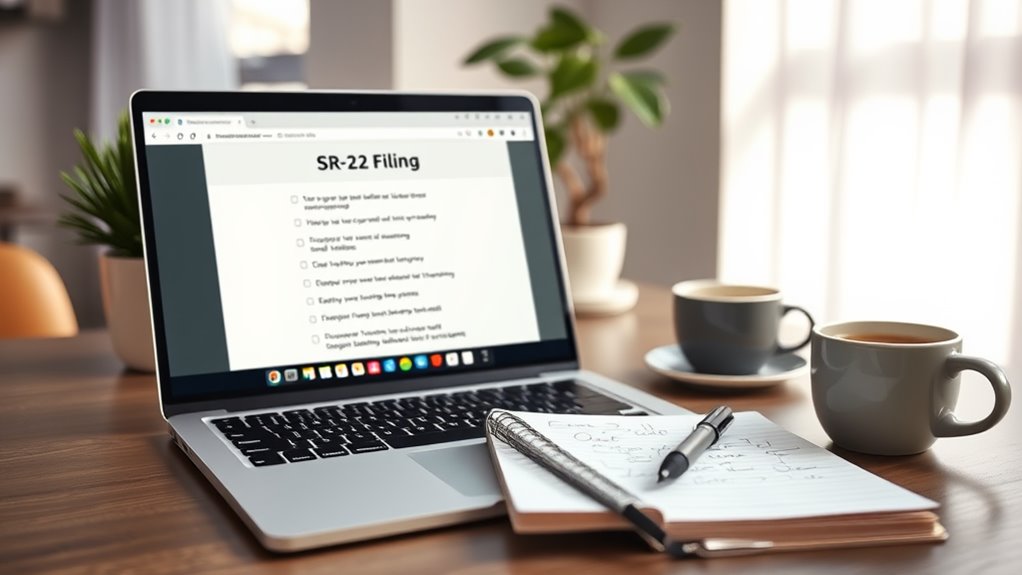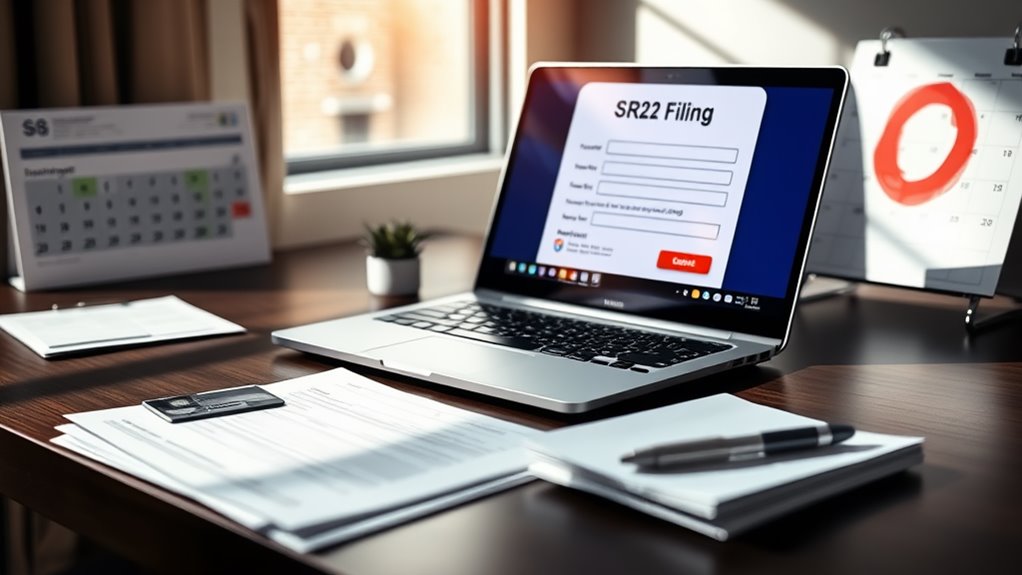7 Steps to File SR22 After License Suspension
If you've faced a license suspension, filing for an SR-22 can feel intimidating. Understanding the specific requirements for non-owner policies is essential, especially if you don't own a vehicle. You'll need to gather important documentation and verify your eligibility with your insurance provider. Completing the SR-22 application accurately is important to avoid further complications. Let's break down the essential steps you need to take to regain your driving privileges efficiently.
Key Takeaways
- Confirm your eligibility for SR-22 filing with your current insurance provider or explore alternative insurers if they don't support it.
- Gather necessary documentation, including proof of identity, residence, and any court sentencing documents related to your license suspension.
- Complete the SR-22 application accurately, providing required information like your social security number and vehicle identification number (if applicable).
- Review insurance quotes and finalize your coverage, ensuring it meets state minimum requirements for liability insurance before making payment.
- Maintain continuous coverage during the SR-22 period, avoiding lapses to prevent further penalties or license suspension.
Understand the SR-22 Requirement for Non-Owner Policies

When managing the aftermath of a license suspension, understanding the SR-22 requirement for non-owner policies is essential. Non-owner SR-22 insurance provides liability coverage for individuals without a car, ensuring compliance with state-mandated minimum requirements. This type of policy is often needed after serious traffic violations, especially for high-risk drivers like those with DUI convictions. It's designed for those who may occasionally drive borrowed or rented vehicles, without the burden of insuring a specific car. Non-owner SR-22 insurance is generally more affordable than standard auto insurance, and it includes a small SR-22 filing fee. Maintaining compliance with state laws is essential to avoid penalties; lapses can lead to further penalties or license suspension, so stay on top of your premiums to remain compliant.
Gather Necessary Documentation for Filing
Once you've secured a non-owner SR-22 policy, the next step is gathering the necessary documentation for filing.
First, you'll need proof of identity, like your driver's license or Social Security number. Gather proof of residence, such as utility bills or bank statements.
You'll also need your insurance policy details, including the policy number and effective date, alongside the SR-22 request form that requires personal and vehicle information.
Don't forget to include court sentencing documents and proof of any legal obligations, like completed DUI programs.
Prepare your payment information for filing fees, which typically range from $15 to $25.
Finally, verify you have liability coverage proofs that meet your state's minimum requirements to confirm compliance.
Check Eligibility With Your Current Insurance Provider
How can you guarantee your current insurance provider supports SR-22 filings? First, contact your provider directly to confirm they handle SR-22 filings.
Not all insurers offer this service, and some may restrict it due to the increased risk associated with high-risk drivers. If your provider does support SR-22, ask about any additional costs, like filing fees, which typically range from $25 to $50.
Also, consider how filing an SR-22 might impact your premiums. If your current provider doesn't support SR-22 filings, you'll need to explore alternative insurance options that do.
Complete the SR-22 Application Process

Completing the SR-22 application process involves several key steps to verify compliance and timely filing.
First, gather required information such as your vehicle identification number (VIN), social security number (SSN), and driver's license details.
Gather essential details like your vehicle identification number (VIN), social security number (SSN), and driver's license information.
Next, contact your insurance provider to confirm they offer SR-22 filings. If not, shop around for alternative companies that do.
Once you've selected a provider, fill out the SR-22 application form accurately and submit it via your chosen method.
Review the insurance quotes and finalize your coverage by completing the payment.
After this, await the SR-22 certificate from your insurance company.
Staying organized throughout this process verifies you meet all necessary requirements and avoid complications later.
Ensure Timely Submission to the DMV
Timely submission of your SR-22 to the DMV is essential for reinstating your license without unnecessary delays.
Contact your insurance provider immediately once you know about the SR-22 requirement. Have your driver's license number, insurance policy details, and the reason for needing an SR-22 ready to expedite the process.
Clarify any doubts about fees and timelines with your insurer to avoid confusion. Proactively follow up with them to guarantee the SR-22 is filed correctly and submitted to the DMV promptly.
Double-check all information provided, including your address and vehicle details, to prevent delays or rejections. Keeping accurate records and maintaining open communication with both your insurance provider and the DMV helps guarantee a smooth submission process.
Maintain Continuous Coverage During the SR-22 Period
Maintaining continuous coverage during the SR-22 period is essential for keeping your driving privileges intact.
If you want to avoid complications, pay attention to the following:
- Understand Minimum Coverage: Ascertain your policy meets your state's minimum requirements, like bodily injury and property damage liability.
- Avoid Lapses: Insurance companies must notify the DMV if your coverage lapses, which can lead to severe penalties.
- Stay Informed: Keep track of your coverage duration, typically lasting three years, to prevent license suspension.
Navigate License Reinstatement Procedures

Once you've served your suspension period, guiding through the license reinstatement procedures is essential for regaining your driving privileges.
Start by reviewing your suspension order for specific requirements. You'll likely need to complete any mandated courses, such as DUI school or defensive driving.
Make certain you have proof of insurance, typically through an SR-22 filing, to demonstrate financial responsibility.
Next, complete the reinstatement application, which may be available online in your state.
Don't forget to pay any associated fees, as these vary based on your suspension reason.
Finally, make certain you meet all conditions outlined in your suspension notice, as non-compliance can lead to further penalties.
Follow these steps diligently to successfully reinstate your driving privileges.
Conclusion
In the journey to reclaim your driving privileges, steering through the SR-22 filing process is essential. By understanding the requirements, gathering the right documents, and ensuring continuous coverage, you're setting yourself up for success. Remember, while it may feel like a winding road, each step brings you closer to reinstatement. Stay informed and proactive, and soon enough, you'll be back on the road, embracing the freedom of driving once more. Your diligence will pay off in the end.
